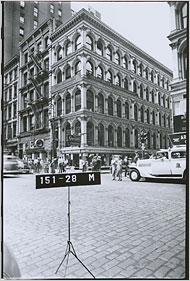“I wish I had thought to ask my grandmother...”
It is a sentiment that is commonly uttered by patrons at the NEHGS reference desk. And, as a genealogist, I can see the frustration. Because it is often these small details, these seemingly insignificant relationships that can help to break down age-old brick walls. But, and I think more importantly, these small details also allow researchers to connect with their ancestors on a more personal level. So, rather than recording dates and names (which, yes, are also important), genealogists should also aim to learn more about the lives of their family members.
To do so many genealogical societies, blogs, and family history sites encourage genealogists to interview their relatives (while taking copious notes) about their day-to-day lives. These authorities often provide lists of open-ended questions, as they allow the interviewee to speak freely about their past. For example: Can you tell me about the day your first child was born? Or: What was a typical family dinner like? Some of these questions are available on the following free sites:
http://www.familytreemagazine.com/article/20-questions
https://familysearch.org/blog/en/52-questions-52-weeks/
http://genealogy.about.com/cs/oralhistory/a/interview.htm
And while the above questions are a great way to get a conversation flowing, there are also other ways to stimulate memories from our ancestors. May I offer some advice of my own?
My maternal grandmother, Mary Mohan (or Nana), was born in Bronx, New York, in 1932 to Patrick Mohan and Mary Rogan, Irish immigrants. Happily, Nana has always been one for storytelling, so I have been on the receiving end of countless stories about World War II war rations, street games, babies, the weather, her mother and father, and so on.
Because of these stories, I feel a very close connection to her, as I know not only what she was like as a child and teenager, but also what she is like as a mother and grandmother. But I am always trying to get her to tell more stories about her parents and her childhood. This task has become more difficult over the years, as I have already asked the most obvious questions. However, one Thanksgiving, I made a breakthrough, when I showed her the enumeration of her family in the 1940 United States Federal Census.
First, I showed Nana the listing for the Mohan family. She was able to see the names of her brothers, as well as the information for her parents. She made several comments about the information included for the Mohans, but for the most part did not provide any additional insight into the record. However, when I printed off the two pages before and two pages after the Mohan family enumeration, I got more information than I could have asked for.
As I read aloud the surnames of Nana’s neighbors, trying desperately to pronounce the Russian, Italian, and German names correctly, she began to tell stories about each of her neighbors. “Oh, Mrs. Plag, she taught me the proper way to iron,” or, “Yes, the Denners were our German immigrant neighbors.” On and on, as I went down the list, she told more and more stories of her childhood. I made notations next to each of the families, asking follow-up questions as we went. It was a wonderful way to learn more about my Nana’s life in New York City.
After the success of the 1940 United States Federal Census record, I looked for more resources that would spark memories with Nana. To do so, I ordered a black and white tax photograph of her apartment building from the New York Municipal Archives in New York City. Upon showing her the photo (as well as a photo of my Papa’s apartment building), the stories of her neighbors, other buildings, and the cars that were parked on the street began to flow freely. Nana and Papa began telling details of their lives that I would have never thought to ask about.
Therefore, when you are surrounded by family and friends this holiday season, don’t limit yourself to the static interview questions from above. Be sure to also show old photographs and documents, as they may spark some new stories. It worked for me, and for that, I am truly thankful.
Share this:
About Lindsay Fulton
Lindsay Fulton joined the Society in 2012, first a member of the Research Services team, and then a Genealogist in the Library. She has been the Director of Research Services since 2016. In addition to helping constituents with their research, Lindsay has also authored a Portable Genealogists on the topics of Applying to Lineage Societies, the United States Federal Census, 1790-1840 and the United States Federal Census, 1850-1940. She is a frequent contributor to the NEHGS blog, Vita-Brevis, and has appeared as a guest on the Extreme Genes radio program. Before, NEHGS, Lindsay worked at the National Archives and Records Administration in Waltham, Massachusetts, where she designed and implemented an original curriculum program exploring the Chinese Exclusion Era for elementary school students. She holds a B.A. from Merrimack College and M.A. from the University of Massachusetts-Boston.View all posts by Lindsay Fulton →
